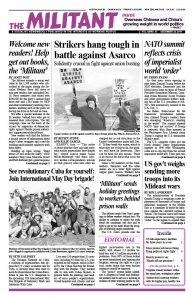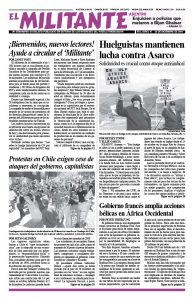The administration of President Donald Trump is weighing a new deployment of thousands of troops and additional weaponry to the Middle East as it continues to battle for influence against the capitalist regime in Tehran. The Iranian rulers have taken advantage of the unraveling capitalist “order” in the region to expand their military and political reach in Iraq, Syria, Lebanon, Gaza and Yemen.
Meanwhile, anti-government protests in Iraq, Lebanon and inside Iran itself have faced brutal assaults from those governments as well as counterrevolutionary paramilitary forces organized by the clerical regime in Iran.
Even as its dominance in the region weakens, Washington continues to defend its imperialist interests and to strike at its foes. The U.S. rulers’ military maneuvers and economic sanctions against Tehran continue, weighing heaviest on working people there. At the same time, President Trump says he wants to withdraw U.S. forces from the region, but finds he can’t.
The Dec. 4 Wall Street Journal reported that up to 14,000 more U.S. troops could be sent to the region, which would double the number sent since the start of a troop buildup in May. The number of warships stationed in the vicinity has also grown, along with new air and ground units. The Pentagon has reestablished a major air base in Saudi Arabia for the first time in 16 years.
On any given day Washington has between 60,000 and 80,000 troops deployed in the Middle East and Afghanistan.
To justify a new buildup, Pentagon officials say they have intelligence reports that Tehran transferred short-range rockets into Iraq. And a U.S. warship recently intercepted a boatload of missiles headed for Iranian-backed Houthi rebels in Yemen, who are fighting a proxy war against Saudi-backed forces there.
Speaking at a regional “security” conference in Bahrain Nov. 23, Gen. Kenneth McKenzie, chief of U.S. Central Command, bemoaned the fact that “there is a lot of water to cover” for Washington’s Navy. While the Pentagon is moving to step up its naval footprint against Tehran, it is also pressed to deploy naval power to counter Beijing’s continuing military buildup in the Pacific.
However, only five of the U.S. rulers’ 11 aircraft carriers are currently deployable — the rest are being repaired, serviced or are currently stationed stateside.
Protests in Iraq, Lebanon
Up to 25 people were killed when both Iraqi security forces and masked thugs attacked anti-government protesters occupying Tahrir Square in central Baghdad Dec. 7. The thugs carried out a series of deadly gun and knife attacks. They are armed groups operating under the umbrella of Tehran-organized militias known as the Hashd al-Shaabi, which function as part of the Iraqi military.
Over 440 Iraqis have been killed, over 20,000 wounded and many more detained or disappeared.
After the violence escalated, Iraqi Prime Minister Adel Abdul-Mahdi was forced to resign. The country’s top Shiite cleric, Grand Ayatollah Ali Sistani, withdrew his support from Mahdi’s government and backed protesters’ calls for no “foreign interference” from either Tehran or Washington in choosing a new government.
Nevertheless, both Gen. Qassim Soleimani, head of the Iranian government’s counterrevolutionary interventions abroad, and Mohammed Kawtharani, from Tehran-backed Hezbollah in Lebanon, have participated in some of the talks. And Washington continues to press its interests.
In Lebanon anti-government protests that forced Prime Minister Saad Hariri to step down Oct. 29 show no signs of abating. Samir Khatib, the privileged head of a large construction firm there, sought to become the new prime minister for a few days. But he abruptly withdrew Dec. 8 and Hariri said he was willing to retake the reins.
Protesters have demanded the whole political setup — which requires the three top government offices to be occupied by a Sunni, a Shiite and a Maronite Christian — be scrapped. The demonstrations have been attacked by Tehran-backed Hezbollah forces.
Iran protests put down in blood
For now the Iranian rulers have brutally suppressed the deepest unrest by working people there since the Iranian Revolution in 1979. Protests in the hundreds of thousands erupted across the country in mid-November after a fuel price hike, but rapidly expanded demands against the government and Tehran’s military maneuvers and aid to proxy military forces abroad.
Hundreds were killed and over 7,000 imprisoned during the protests. According to media reports, Revolutionary Guard forces in Mahshahr mowed down over 100 youths with machine gun fire Nov. 18.
The clerical regime announced Dec. 8 that in the face of Washington’s sanctions and the growing economic crisis they intend to continue steps to reduce government programs and expand cuts on subsidies for gas and electricity. These moves, which led to the protests, put the burden of the crisis even more onto the backs of working people.

